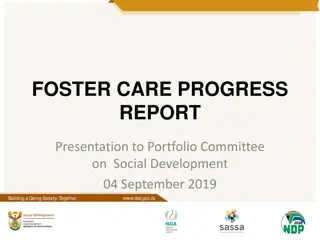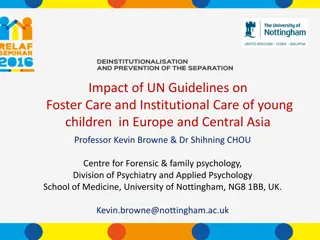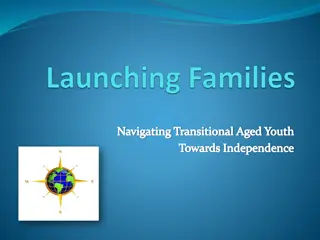Enhancing Educational Support for Foster Care Students
Addressing challenges faced by students in foster care, this resource discusses educational definitions, hurdles, and concerns in Michigan's education system. It highlights the low graduation rates among foster care youth, credit transfer issues, and the importance of educational stability for these vulnerable students, emphasizing the need for collaboration between agencies. The document also sheds light on the foster care experience, emphasizing the impact of frequent home moves, trauma, and lack of educational support in their academic journey.
Download Presentation

Please find below an Image/Link to download the presentation.
The content on the website is provided AS IS for your information and personal use only. It may not be sold, licensed, or shared on other websites without obtaining consent from the author.If you encounter any issues during the download, it is possible that the publisher has removed the file from their server.
You are allowed to download the files provided on this website for personal or commercial use, subject to the condition that they are used lawfully. All files are the property of their respective owners.
The content on the website is provided AS IS for your information and personal use only. It may not be sold, licensed, or shared on other websites without obtaining consent from the author.
E N D
Presentation Transcript
Supporting Educational Success for Students Experiencing Foster Care Ann Rossi Kathleen Hoehne Foster Care Consultant Office of Educational Supports Michigan Department of Education Departmental Analyst Foster Care, Guardianship and Adoption Program Office Michigan Department of Health and Human Services 1
Education Definitions School of Origin The local education agency that a student was attending prior to placement change. School of Residence The local education agency in which a student is now residing. Local Education Agency (LEA) local agency existing to operate schools or contract for educational services State Education Agency (SEA) state-level government organization who is responsible for education and providing information, resources and technical assistance to LEAs. 2
Education Challenges Youth experiencing foster care graduate high school at the lowest rate of any subgroup of students. Often, LEAs are unaware of student status within the foster care system and are left out of critical conversations. High school credits do not transfer equally from one school to another. Each LEA can evaluate previous credits earned and assign as they desire. There are no protections for transfer credit in Michigan. Michigan Merit Curriculum Graduation Requirements include a universal 18 credit accumulation for a Diploma. Michigan currently has 893 open-active LEAs, each can add their own unique High School Graduation Requirements. For highly mobile student populations, this causes delays in graduation 3
Concerns from the Field The MDE and MDHHS are often contacted by LEAs that there is a court order mandating who pays for transportation. The MDE and MDHHS often hear from LEAs that they are not included in the educational discussion. The MDE and MDHHS are often contacted when a student is placed in an LEA that is not their School of Residence or the School of Origin. 4
The Foster Care Experience The Child Welfare system is focused on safety and permanence NOT on education. Children/Youth in foster care: Have frequent home moves, which leads to high education mobility and subsequently, students fall behind academically. Youth experience trauma prior and/or during their time in foster care. May not be coming from families with a high emphasis on education. Can lack supportive adults to help them navigate college access. 5
Students in foster care have the right to: Remain in their school of origin Have transportation arranged and provided Attend a traditional school regardless of high school credit history Education Rights of Youth in Care Participate in any extra curricular activities Transition planning Graduate with their same-age peers Receive all LEA approved Title and 31a services along with any identified special education services. 6
Best Interest Factors Foster care workers must consider the following factors regarding school placement: The parents or guardians and child s school of preference. Educational input from school personnel and district liaison. The child s/youth s: Social and emotional state Academic achievement/strengths/weaknesses Continuity of relationships Special education programming Extra-curricular activity participation Distance/travel time to and from current school/new placement and the impact of commute on the child (cost cannot be a factor) Supportive relationships and/or services Length of anticipated stay in placement and permanency plan 7
Michigan Revised School Code Act 451 MCL 380.1148(2) In 2009, Michigan revised the school code: A school district must allow a student to enroll in and attend the appropriate grade in the school selected by the Department of Health and Human Services or a child placing agency without regard to whether or not the student is residing in that district. If the selection results in a student transferring to another school, the school records must immediately be transferred to that new school. 8
Immediate Enrollment When remaining in the school of origin is not possible or found in the best interest, the student must be immediately enrolled in a new school. A school cannot deny enrollment based on the lack of otherwise required documents. The case worker must assist with providing any available educational records that may be helpful in the enrollment process. 9
Notification and Records Release Form The DHS-942, Education Notification and Record Release form is required to be sent to the Foster Care Liaison at the school: When a student first enters foster care, whether a school move is required or not. Any time a student moves foster home placements while in care, whether a school move is required or not. Any time a student transfers schools. When a case worker is completing the case service plan. Any time there is a case worker change. When a foster care case closes. 10
Federal Education Law passed in December 2015 Every Student Succeeds Act of 2015 (ESSA) Updates Elementary and Secondary Education Act (ESEA) Replaces the No Child Left Behind Act Amended the McKinney-Vento Homeless Assistance Act 11
Every Student Succeeds Act of 2015 Requires, for the first time, that ALL students be taught to high academic standards that will prepare them to succeed in college and career. Requires new federal data reporting at the state level for: graduation/drop-out and academic achievement. Michigan reported this information to US Ed for 2017-2018, 2018-2019, 2019-2020 and 2020-2021 SYs Upholds critical protections for disadvantaged and high-need students, including foster, students of military families and homeless students. 12
District Foster Care Liaison Responsibilities District Foster Care Liaison responsibilities include: Know who the students in your LEA are who are in care. Run the MSDS Direct Certification Student Roster Report regularly (every two weeks). Ensure that children in foster care are IMMEDIATELY enrolled in and are regularly attending school. Ensure transportation procedures are in place to maintain students in their school of origin, when determined to be in their best interest. Create a Communication Plan for your LEA specific to foster students. 13
District Foster Care Liaison Responsibilities Cont. Participate with the Best Interest Determination discussion or any other meeting that impacts student education. CWS and Courts should consider including LEAs. Facilitate the transfer of records and immediate enrollment. Facilitate data sharing with the Child Welfare Agencies consistent with FERPA and other privacy protocols. Facilitate transportation cost agreements between the LEA and the Child Welfare Agency. 14
Directions for Accessing Contacts in the Educational Entity Master (EEM) Access the website: https://cepi.state.mi.us/eem/EntityS earchQuick.aspxClick Search Select Quick Under Entity Name type in the name of the local education agency (LEA) Click Search Select the district from the list (there may be several pages to look through), click on the blue underlined name Scroll to the bottom of the page Under the Admin/Contacts tab, using the scroll bar, find Foster Care Liaison There will be a name and a phone number listed. If you would like an email address, click on the Details button to find the person s contact email. www.Michigan.gov/eem 15
IDENTIFYING STUDENTS IN FOSTER CARE Generate a list in your LEA by following these directions: Run the Student Roster Report in MSDS. Sort the spreadsheet on the Foster column. This activity should be completed every two weeks following the Fall Count Date. *IF you do not have authority in MSDS to complete this activity, set up regular times with the whomever in your LEA does have this level of access in MSDS. 16
Serve as main go-to person for district foster care liaison. Receive specialized training and technical assistance on education policy/procedures. Tasked with getting information to child welfare staff at MDHHS and private agencies. Provide technical assistance and support to foster care caseworkers as they: Notify school districts when a child has been placed in foster care in the LEA, moves out of the LEA, or when a foster care placement changes Coordinate transportation plans and payment Make Best Interest Determinations MDHHS Education Points-of- Contact 17
Foster Care Transportation Each LEA must have a Foster Care Transportation Plan/Procedure uploaded into the Grants Electronic Management (GEMS) platform. A Sample Foster Care Transportation Plan can be found on the MDE Foster Care webpage. Transportation to and from the school of origin, if it is found in the best interest, is a right of the student and should be a collaborative arrangement between agencies. 18
Additional costs incurred in providing transportation to the school of origin should reflect the difference between what an LEA otherwise would spend to transport a student to his or her assigned school and the cost of transporting a child in foster care to his or her school of origin. Definition of Additional Costs for Transportation *Non-Regulatory Guidance Question #27 19
Transportation Reimbursement The suggested structure for reimbursing Additional Costs for transporting foster students to their school of origin if determined to be in the student s Best Interest, is as follows; If a student s foster care placement is being funded by Title IV-E funds, MDHHS will reimburse Additional Costs of transportation at 100% If a student s foster care placement is not being funded by Title IV-E, MDHHS will reimburse Additional Cost of transportation up to the rate of 50% and the district may be responsible for the remaining 50% NOTE: MDHHS does not have responsibility for the cost of school transportation if the child is attending the school of residence. 20
Transportation Reimbursement cont. Child welfare workers have 30 days to make Title IV-E eligibility determination and notify LEAs. During the window of Title IV-E eligibility determination, LEAs are responsible for providing transportation with possible 100% or up to 50% reimbursement from MDHHS. Child welfare workers are responsible for notifying LEAs if student s placement Title IV-E eligibility changes. LEAs may use Title I, Part A funds to cover non-reimbursed costs for Additional Cost of transportation. 21
Michigan has a basic requirement of 18 Michigan Merit Curriculum (MMC) Credits necessary for high school graduation. Every local education LEA can add their unique graduation criteria in addition to the MME requirements. Michigan Graduation Requirements Michigan has 893 open-active LEAs. Currently, there are no high school credit protections within Michigan for highly mobile student populations. 22
Michigan Subgroup Graduation Comparison 4 Year Cohort 23
Recommendations to Improve Student Outcomes ESSA requirements for students experiencing foster care are not enough to ensure successful high school graduation. All parties involved in case planning need to communicate/collaborate more effectively. States and LEAs need to continually review and analyze student data to identify outcome trends. States and LEAs need to identify how student outcome data demonstrates the impact of unintended consequences of legislation. (ie: in MI, the number of LEAs including PSAs, all having individual graduation requirements). 24
How Case Workers Can Support Education For Students In Foster Care Help educate school staff regarding the experiences and behavior of youth who have been in care Identity LEA Foster Care Liaison via the EEM Communicate with LEA regularly Encourage caregivers to be actively engaged in the education of youth in their care Invite appropriate school staff to Family Team Meetings (FTM) Participate in school related meetings 25
Let caseworker know you want to be notified of Individualized Education Program (IEP) meetings. Participate in IEP meetings when possible. When not available for IEP, check in with caregiver/youth on how things went. Tips for Guardian Ad Litem (GAL) Ask child/youth how things are going in school. Attend Family Team Meetings (FTM) when possible. 26
Questions for court to consider at initial removal or replacement Has the caseworker been in contact with the school foster care liaison? Was an education Best Interest Determination completed in collaboration with the school to make school placement decision? Were all appropriate parties involved (school representative, parent, foster parent, student, etc.)? What is the transportation plan? Is it feasible and age appropriate? How many placements and/or schools has the child/youth attended? 27
Questions to Ask Youth at Hearing How is school going overall? Do you have someone at school who you can reach out to for questions or help? Are there services or resources you feel are needed that you are not getting? For older youth; Have you participated in Semi-Annual Transition meetings/Family Team Meetings and has education been addressed at those? For older youth; If you changed schools this year, are you in the same grade you were in at the previous school? For older youth; Are you on track to graduate? For older youth; Are you aware of available post-secondary resources? 28
Questions? 29
Resources US ED/HHS Joint Foster Care Guidance https://www2.ed.gov/policy/elsec/leg/essa/edhhsfostercarenonregulatorguide.pdf State of Michigan Websites https://www.mischooldata.org/Default3.aspx http://www.michigan.gov/mde/0,4615,7-140-6530_30334_51051-428655--,00.html http://www.michigan.gov/mdhhs/0,5885,7-339-71551_11120_78699---,00.html https://dhhs.michigan.gov/OLMWeb/ex/FO/Public/FOM/000.pdf#pagemode=bookmarks https://cepi.state.mi.us/eem/ 30
Ann Rossi Kathleen Hoehne Foster Care Consultant Office of Educational Supports Michigan Department of Education HoehneK@michigan.gov 517-243-7171 Departmental Analyst Foster Care, Guardianship and Adoption Program Office Michigan Department of Health and Human Services RossiA@michigan.gov 517-256-8421 31























